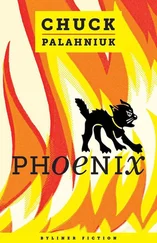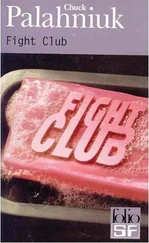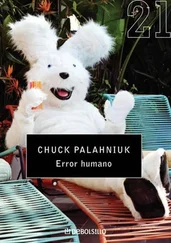Chuck Palahniuk
Invisible Monsters Remix
P U B L I S H E R ’ S N O T E :
All type irregularities in the text are intended
The Wish Book: A Reintroduction to Invisible Monsters
 his is how old I am: I loved the Sears catalogue. It kills me that I now need to explain what that was. It was an inventory of everything you ever dreamed of owning. Imagine the entire Internet printed on paper and bound along one edge—a stack of glossy paper as thick as a telephone book. Please don’t ask me to explain what a telephone book was. By now you imagine I’m wearing a bowler hat and a celluloid collar, driving my horseless carriage, lickety-split, to a torrid three-way with Laura Ingalls Wilder and Abraham Lincoln.
his is how old I am: I loved the Sears catalogue. It kills me that I now need to explain what that was. It was an inventory of everything you ever dreamed of owning. Imagine the entire Internet printed on paper and bound along one edge—a stack of glossy paper as thick as a telephone book. Please don’t ask me to explain what a telephone book was. By now you imagine I’m wearing a bowler hat and a celluloid collar, driving my horseless carriage, lickety-split, to a torrid three-way with Laura Ingalls Wilder and Abraham Lincoln.
As opposed to you, you who’ll always stay so young and hip.
Be that as it may. This modern world isn’t all it’s cracked up to be.
Nowadays, whatever purchase you moon over, whatever person you lust after, most likely it’s presented on a smooth glass or plastic screen. On a laptop or a television. And no matter what the technology, you’ll catch sight of your own reflection. In that electric mirror, there hovers your faint image. You’ll be superimposed over every email. Or, lurking in the glassy surface of online porn, there you are. Fewer people shut down their computers anymore, and who can blame them? The moment that monitor goes black, you’re looking at yourself, not smiling, not anything. Here’s your worst-ever passport photo enlarged to life size. Swimming behind the eBook words of Jane Austen, that slack, dead-eyed zombie face, that’s yours. That’s you.
The Sears catalogue was better. The paper reflected nothing. You could lose yourself in the Sears catalogue. The one published for the Christmas season they called the “Wish Book,” and seldom has a name been more accurate because it held hundreds of pages of toys and food and clothes, tools, and you-name-it. You could never remember it all, and every time you opened that book you found something you’d never seen before. Every time you cracked those pages you fell in love. Children and young people are always looking for an anchor, a tether, some attachment to ground them in the impossible world. The objects in the Sears catalogue baited you into adulthood. You couldn’t wait to find a job, any job, and start buying stuff. The vastness of stuff was unknowable. It was the world.
That’s how I originally structured this book: to be a little unknowable. Reader friends complained about how the dwindling number of pages, those physical sheets of paper you held between the thumb and index finger of your right hand, suggested when the plot of a novel was reaching its climax. At the time I had no washing machine. We’re talking 1991. I took my dirty clothes to a Laundromat called City Laundry every Tuesday after work. The place was cluttered with old magazines, old Vogue magazines brought in by the owner, Gretchen. They were the only reading material, and I tried reading them. The pages were seldom numbered. The pages were chockablock with artsy photos and quotes, enlarged and lifted out of context. In articles, the feature copy started near the front of the magazine but quickly “jumped” to pages near the back. Trying to read a story was like trying to navigate through a Las Vegas casino. It was designed to entice and seduce you. It was designed to trap you. I got lost. I loved it. I told myself, Why can’t a novel do this?
So that’s how I originally wrote this book. The story would not unspool as a continuous linear series of “and then, and then, and then’s …” At the end of the first chapter, the reader would be directed to jump to, for example, Chapter Thirty. At the end of Chapter Thirty, she’d be told to jump to Chapter Sixteen. Following the plot would mean paging forward and backward, and you’d never know where the story might end. It might all come to a head at the physical center of the book. Better yet, as you hunted for the next chapter, you’d glimpse marvelous, ridiculous scenes, and you’d wonder, “How will the story ever get there ?”
Most of the book I wrote while watching music videos on MTV. Yes, that’s how old I am. Back then MTV still played videos. Now, no doubt, you picture me wearing high-button shoes and rolling a hoop down a dirt road in—I don’t know—ancient Thebes?
Nobody ever had so much fun writing a book. I’d be couch surfing with Alexander Graham Bell and Dolley Madison, watching Echo & the Bunnymen videos. Abraham Lincoln would order a pizza, and Bell would offer everyone hits of MDA. That’s how far back this happened, we didn’t call Ecstasy “E.” We didn’t even call it “X.” Louisa May Alcott would be rolling us a fatty.
I’d shake my head no. I’d whine, “Guys, I can’t get high . I need to write my novel .”
And Harriet Beecher Stowe would say, “Dude, why can’t you do both ?”
You young people, you who think you invented fun and drugs and good times, fuck you.
That was my original plan for Invisible Monsters . Even after the reader reached the words “The End” she’d still sense she hadn’t read it all. The book would still hold some lingering secrets. You could open it again and find something—as with the Sears catalogue or Vogue magazine or anyone you love—something that you’d never seen before. Think D. H. Lawrence’s “Odour of Chrysanthemums” but scored with music by Bronski Beat. That’s how I originally wrote this book. It was packed with jumps. Hidden secrets. Buried treasure. I gave the original manuscript to a friend, Monica Drake, the author of Clown Girl . She read it the way she had read every other book, from beginning to end …page one, page two, page three …and then, and then, and then …She told me that jumping was too difficult. “Readers,” Monica warned me, “most readers, aren’t going to want to work that hard.” They’d get lost. Back then, neither Monica nor I had been published. We didn’t want to make trouble. We just wanted for people to love us.
So I hammered the story into a nice, smooth, straight line. I threw out the magic. A wonderful publisher bought the rights. It was launched in 1999 as a paperback. It’s only ever been a paperback. End of story.
Still, Harriet’s words kept echoing in my head: “Why can’t you do both?”
Twelve years later, the publisher W. W. Norton suggested producing a hardcover version of the book, and I saw my chance. The Brandy Alexander Witness Reincarnation Program. I told myself: Here we go again. Where you’re supposed to be is some big West Hills wedding reception in a big manor house with flower arrangements and stuffed mushrooms all over the house …
You might mark every page with a little X, like leaving a trail of bread crumbs, to make sure you read them all. Or don’t. Me, personally? I hope you get lost. I mean, really, would that be so bad?
Now, Please, Jump to Chapter Forty-One
 on’t expect this to be the kind of story that goes: and then, and then, and then.
on’t expect this to be the kind of story that goes: and then, and then, and then.
What happens here will have more of that fashion magazine feel, a Vogue or a Glamour magazine chaos with page numbers on every second or fifth or third page. Perfume cards falling out, and full-page naked women coming out of nowhere to sell you makeup.
Don’t look for a contents page, buried magazine-style twenty pages back from the front. Don’t expect to find anything right off. There isn’t a real pattern to anything, either. Stories will start and then, three paragraphs later:
Читать дальше

 his is how old I am: I loved the Sears catalogue. It kills me that I now need to explain what that was. It was an inventory of everything you ever dreamed of owning. Imagine the entire Internet printed on paper and bound along one edge—a stack of glossy paper as thick as a telephone book. Please don’t ask me to explain what a telephone book was. By now you imagine I’m wearing a bowler hat and a celluloid collar, driving my horseless carriage, lickety-split, to a torrid three-way with Laura Ingalls Wilder and Abraham Lincoln.
his is how old I am: I loved the Sears catalogue. It kills me that I now need to explain what that was. It was an inventory of everything you ever dreamed of owning. Imagine the entire Internet printed on paper and bound along one edge—a stack of glossy paper as thick as a telephone book. Please don’t ask me to explain what a telephone book was. By now you imagine I’m wearing a bowler hat and a celluloid collar, driving my horseless carriage, lickety-split, to a torrid three-way with Laura Ingalls Wilder and Abraham Lincoln. on’t expect this to be the kind of story that goes: and then, and then, and then.
on’t expect this to be the kind of story that goes: and then, and then, and then.



